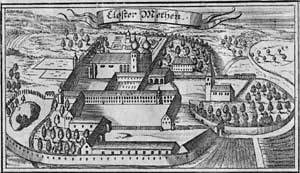
Frauenzell Abbey was a Benedictine monastery situated in Frauenzell, which is part of Brennberg in Bavaria, Germany.

Metten Abbey, or St. Michael's Abbey at Metten is a house of the Benedictine Order in Metten near Deggendorf, situated between the fringes of the Bavarian Forest and the valley of the Danube, in Bavaria in Germany.

Kirche am Hohenzollernplatz is the church of the Evangelical Congregation at Hohenzollernplatz, a member of today's Protestant umbrella Evangelical Church of Berlin-Brandenburg-Silesian Upper Lusatia. The church is located on the eastern side of Hohenzollernplatz in the locality of Wilmersdorf, in the Berlin borough of Charlottenburg-Wilmersdorf. The building is considered a leading example of Brick Expressionism and a testimonial to the unique quality of expressionist church architecture in Berlin. The naming of the church after the city square it faces was originally considered a temporary solution until a more suitable one was chosen. The name stuck however, though the debate continues.

Johannes (Johann) Zick was a German painter of frescoes in southern Germany and active during the Baroque period. He was the father of painter Januarius Zick and considered to be an important master of the Late Baroque.

The Cathedral Basilica of the Assumption or Pelplin Abbey is a former Cistercian abbey, located in Pelplin, Poland, to the south of Gdańsk.

Liebenstein Castle is a castle in Liebenstein in the Ilm-Kreis, Thuringia, Germany. It was originally built in the 12th century by the counts of Käfernburg; the castellans were the counts' ministeriales, the lords of Liebenstein.

Maria Regina Martyrum is a Roman Catholic church of the Roman Catholic Archdiocese of Berlin in Berlin, borough Charlottenburg-Wilmersdorf, in the locality of Charlottenburg-Nord. The church was built on behalf of the German Catholics to honour the Martyrs of Freedom of Belief and Conscience from the years 1933–1945. It is located 20 min of walk from the place of execution of Nazi resistants and opponents within the Plötzensee Prison, now the memorial Gedenkstätte Plötzensee.

Tabor Church (Wilhelmshagen) is one of the three churches of the Evangelical Berlin-Rahnsdorf Congregation, a member of today's Protestant umbrella organisation Evangelical Church of Berlin-Brandenburg-Silesian Upper Lusatia. The church building is located in the quarter Wilhelmshagen, locality Rahnsdorf, borough Treptow-Köpenick of Berlin. The church was named in memory of the Transfiguration of Jesus, which allegedly took place on Mount Tabor הר תבור in today's Israel.

Gethsemane Church is one of four church buildings of the Lutheran Northern Prenzlauer Berg Evangelical Congregation, within the Evangelical Church of Berlin-Brandenburg-Silesian Upper Lusatia, an umbrella organisation which includes Lutheran, Reformed, and United Protestant Calvinist congregations.

Johann Jakob Zeiller was an Austrian painter.

The Grillenburg is a ruined medieval castle in Grillenberg in the district of Mansfeld-Südharz in the German state of Saxony-Anhalt. It was a small knight's castle built for a ministerialis.

The Odeon is a former concert hall in the Odeonsplatz in Munich, Bavaria, Germany, which is named after it. Built in the early 19th century to a design by Leo von Klenze and forming a counterpoint to the externally identical Palais Leuchtenberg, it was rebuilt after being almost totally destroyed in World War II and now houses the Bavarian Ministry of the Interior.
Gerhard Vinken is a German art historian and a professor at the University of Bamberg.
The Deutscher Kunstverlag (DKV) is an educational publishing house with offices in Berlin and Munich. The publisher specializes on books about art, cultural history, architecture, and historic preservation.

St. Moritz, also St. Mauritius, is a church in Halle (Saale), Saxony-Anhalt, Germany, dedicated to St. Maurice. The late-Gothic hall church was built as an Augustine Stiftskirche from 1388. It features late-Gothic stone sculptures and a notable organ from 1925.
Gabriel Mälesskircher, or Mäleßkircher was a German painter; active in Southern Bavaria. He was a representative of the "Second Munich School of Painting".

Maidbronn Abbey was a Cistercian nunnery in Maidbronn in the present municipality of Rimpar in Bavaria, Germany.

St. Johannes Evangelist is a Catholic parish church in Cappenberg, now part of Selm, North Rhine-Westphalia, Germany. It was formerly the abbey church of Cappenberg Abbey built in Romanesque style. It is a listed monument as one of few extant large churches built before the mid-12th century in Westphalia.

Ernst Emil Max Gall was a German art historian and historic preservationist.




















